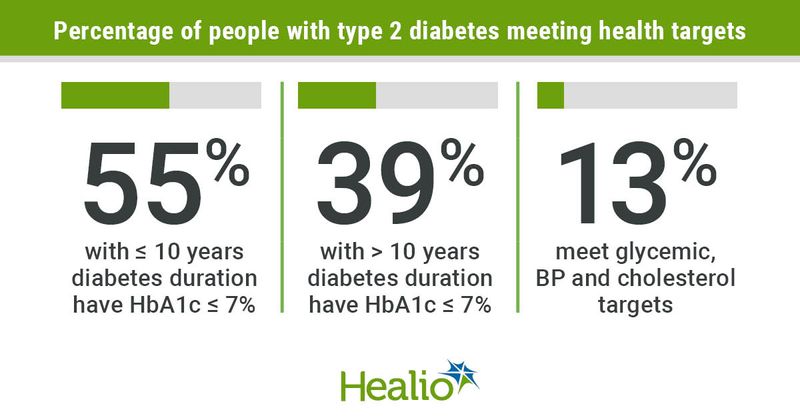Longer diabetes duration lowers likelihood for meeting glycemic targets
People with a longer duration of diabetes are less likely to achieve glycemic targets, according to a study published in Journal of Diabetes and Its Complications.
In an analysis of data from more than 5,000 patients in the Diabetes Mellitus Status in Canada (DM-SCAN) study, researchers found only 13% of people with type 2 diabetes were meeting HbA1c, blood pressure and LDL cholesterol targets, revealing a need for providers to focus on improving care for all patients with diabetes.

“Irrespective of duration of diabetes, attainment of optimal glycemic, BP and LDL cholesterol targets was suboptimal,” Andrew T. Yan, MD, FRCPC, FACC, FSCMR, member of the division of cardiology at St. Michael’s Hospital and associate professor of medicine at the University of Toronto, and colleagues wrote. “There remains an important opportunity to improve the treatment and outcome of patients with diabetes, irrespective of disease duration.”
Researchers collected data from DM-SCAN, a retrospective cross-sectional study of people with type 2 diabetes managed in primary care. Between September and December 2012, researchers collected data from 479 primary care physicians in Canada on HbA1c targets, BP and LDL cholesterol levels, duration of type 2 diabetes, preexisting macrovascular and microvascular disease and treatments. Researchers compared targets and management between 3,462 patients with diabetes for 10 years or less and 1,647 for more than 10 years.
Higher HbA1c targets with longer diabetes duration
Patients with a diabetes duration of longer than 10 years had a higher rate of preexisting coronary artery disease (30.6% vs. 18.2%; P < .001), peripheral artery disease (12.4% vs. 5.5%; P < .001) and strokes (9.4% vs. 3.7%; P < .001) than those with diabetes 10 years or less. Adults with a longer diabetes duration also had a higher rate of retinopathy (15.3% vs. 5.2%; P < .001), neuropathy (18.7% vs. 8.3%; P < .001) and nephropathy (26.3% vs. 9.7%; P < .001).
Those with a shorter diabetes duration were more likely to be assigned HbA1c targets of 6.5% or less and 7% or less, whereas those with a longer diabetes duration were more likely to have an HbA1c target between 7.1% and 8.5%. Patients with a shorter diabetes duration were more likely to have an HbA1c of 7% or less (55% vs. 39%; P < .001) and were more likely to be prescribed diet therapy as the sole treatment for diabetes, whereas a longer diabetes duration was associated with a higher likelihood for taking two or more antihyperglycemic medications and being on insulin therapy.
Few meet glycemic, BP and cholesterol targets
Those with a longer diabetes duration were more likely to be prescribed two or more antihypertensive agents. Diabetes duration was not significantly associated meeting BP targets. Patients with a longer diabetes duration were more likely to be on one or two lipid-lowering medications than those with a shorter diabetes duration (74.7% vs. 70%; P < .001) and had lower LDL cholesterol levels (1.8 mmol/L vs. 2 mmol/L; P < .001). Both the shorter diabetes duration group and the longer diabetes duration group had 13% of its participants meet glycemic, BP and cholesterol targets.
“PCPs were more likely to manage longer diabetes duration patients more aggressively for their cardiovascular risk factors with medications, and more likely to have referred them for lifestyle counseling,” the researchers wrote. “Patients with longer duration of diabetes were more likely to be assigned and have attained glycemic targets between 7.1% and 8.5% while requiring more antihyperglycemic and lipid-lowering medications. While these differences might reflect patient frailty, comorbidities and risk of hypoglycemia, the precise reasons remain to be elucidated.”
